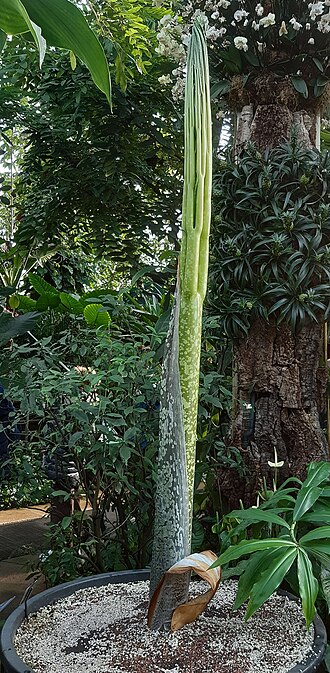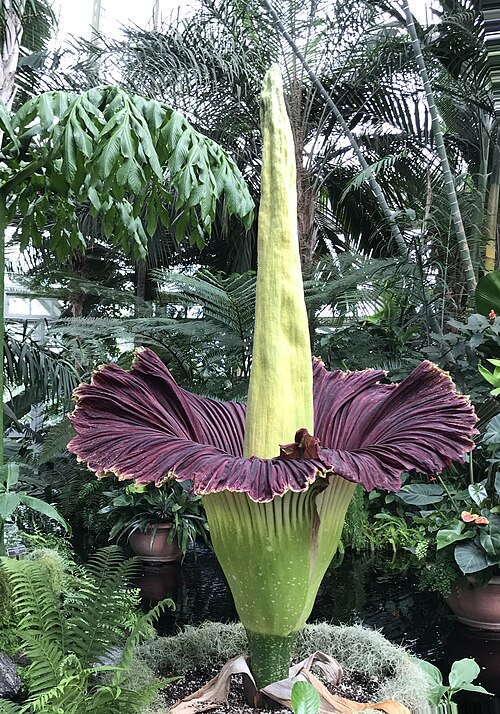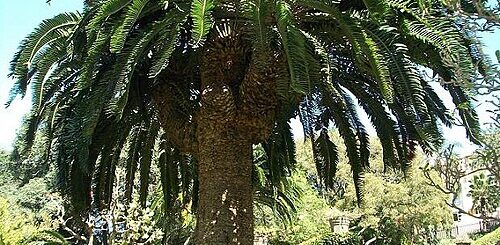Corpse Flower – Nature’s Most Dramatic Bloom

Deep in the rainforests of Sumatra, a strange botanical event unfolds only once every few years. It’s rare, it’s huge, and it absolutely stinks. Meet the Corpse Flower or Titan arum Amorphophallus titanum, one of the most fascinating and foul-smelling plants on Earth.
What Is the Corpse Flower? 🌺
The Corpse Flower isn’t just your average plant. It’s famous for its massive bloom, which can tower over 10 feet tall, and for releasing an odor that’s often described as rotting flesh or dead animals. It’s this gruesome scent that gives the plant its morbid nickname.
Scientifically known as Amorphophallus titanum, the Corpse Flower is native to the tropical rainforests of western Sumatra, Indonesia. It was first discovered in 1878 by Italian botanist Odoardo Beccari, and since then, it’s captured the imagination of scientists, gardeners, and the morbidly curious.

Titan Arum leaf emerging. The plant produces a single leaf at a time. Creative Commons | Author: Chiswick Chap – Source: https://commons.wikimedia.org/wiki/File:Titan_Arum_leaf_emerging.jpg
Why Does It Smell So Bad? 🌡️
That horrifying stench? It’s not just for drama. The smell is actually a survival strategy.
When the flower blooms, something that can take 7 to 10 years, but some may bloom more frequently, such as every 2-3 years, or less frequently. It produces heat and releases a scent cocktail of dimethyl trisulfide, isovaleric acid, and other chemicals that mimic the smell of decay. The goal? To attract carrion beetles and flesh flies, which normally feed on rotting meat. These insects become accidental pollinators, transferring pollen from one Corpse Flower to another.
The bloom only lasts 24 to 48 hours, making it one of the most short-lived and dramatic floral events on the planet.
Not Just One Big Flower 🌱
Though it looks like a single, monstrous bloom, the Corpse Flower is technically an inflorescence, a collection of many small flowers arranged around a central spike called a spadix. Surrounding it is a large, leafy bract called a spathe, which unfurls to reveal a deep maroon interior, another mimic of decaying flesh.
The plant itself spends most of its life underground as a corm, storing energy until it’s ready to make its grand (and smelly) appearance.
Blooms That Draw Crowds 🏛️
Because blooming is so rare, botanical gardens around the world turn into tourist hot spots when one of these giants decides to flower. People wait in long lines to catch a glimpse and a whiff of the bloom. The stench has become such a spectacle that some gardens offer late-night viewing hours for visitors to experience it at its peak stinkiness.
Some famous blooms include:
- >New York Botanical Garden (2018)
- Meise Botanic Garden, Belgium (2024)

New York Botanical Garden corpse flower in bloom June 27, 2018 – Creative Commons | Author: Sailing moose – Source: https://commons.wikimedia.org/wiki/File:Amorphophallus_titanum_(corpse_flower)_-_2.jpg
Endangered and Elusive 🌍
In the wild, Corpse Flowers are endangered due to deforestation and habitat loss. As their native rainforests shrink, so do the chances of natural blooms and cross-pollination. Conservationists and botanists are now working to protect both the species and its habitat.
Many of the Corpse Flowers we see blooming in the U.S. or Europe are the result of decades of cultivation and careful care by dedicated horticulturists.
Beauty in the Beast
The Corpse Flower may be infamous for its ghastly odor, but it’s also a reminder of how diverse, strange, and awe-inspiring the natural world can be. Whether you’re a botanist, a nature lover, or just a fan of the weird and wonderful, the Corpse Flower is proof that sometimes, the most unforgettable experiences in life are the ones that make you wrinkle your nose.










